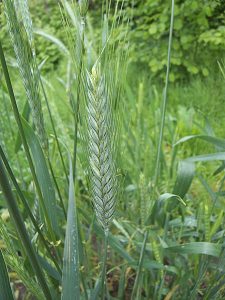Bulletin #2270, Maine Forage Facts: Small Grains Crops
Bulletin #2270, Maine Forage Facts: Small Grains Crops (PDF)
By Jaime Garzon, Assistant Extension Professor and Forage Educator, University of Maine Cooperative Extension
For information about UMaine Extension programs and resources, visit extension.umaine.edu.
Find more of our publications and books at extension.umaine.edu/publications/.
Small Grains Crops
Small grains crops are used as feed components to animal diets, cover crops to protect the soil, competition against weeds, or cash crops focused on grain production. Small grains are fast-growing annual plants, characterized by high biomass production under appropriate weather and soil conditions. They usually thrive in moderately to well-drained soils with a pH above 5.8.
Small grain species in Maine
Oat (Avena sativa L.)
Oats are used for grain, straw, silage, pasture, hay, or as nurse crops for other forage seedlings. The seeding is usually done in May or September, after triticale in spring, a warm season crop in summer, or 30–40 days before the first frost if directed as a winter crop. Oats will not survive the winter, making it a good option for a cover crop in the fall, then to start clean with a new crop in the spring of the following year.
The recommended seed rate is 40–60 pounds per acre as a cover crop or 75–100 pounds per acre as forage, reaching approximately 28–34 plants per square foot. The seeds need to be planted at 1 to 1.5 inches deep. Seeds are available covered or naked (hull-less) without affecting the seedling performance in new varieties. Naked seed usually comes with some treatment cover to avoid mold contamination.
As a grass, oats have a high nitrogen requirement. It is advisable to obtain fertilization recommendations from soil analysis before sowing. In case of not having it, apply 40 pounds of nitrogen per acre for soils with 2–10 percent organic matter, or 60 pounds per acre with less than 2 percent organic matter. Liming should occur at least two weeks before planting, and nitrogen should be applied one week after seed emergence, waiting for the seedling to have roots to absorb the nitrogen applied. If applied at seeding, do not apply more than 2 pounds of nitrogen per acre or 45 pounds of nitrogen+potash mixed per acre to avoid fertilizer injury.
Some oat varieties available in Maine are Cosaque (better as a winter crop), Canmore (medium maturity), Everleaf, and Kara, both for forage production.
Oat productivity ranges from 1,400–3,200 pounds per acre (40–100 bushels per acre) after 35–40 days post-emergence when seed heads start to appear (pre-heading stage). The University of Maine has conducted oat variety trials since 2019, and they are available on the University of Maine Cooperative Extension website. The reports concluded the best performance of the Hayden variety with covered seed and Everleaf for naked seed in 2010, with the application of 60 pounds of nitrogen per acre.
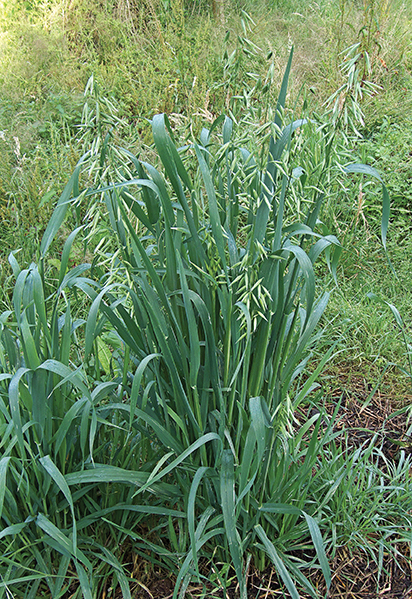
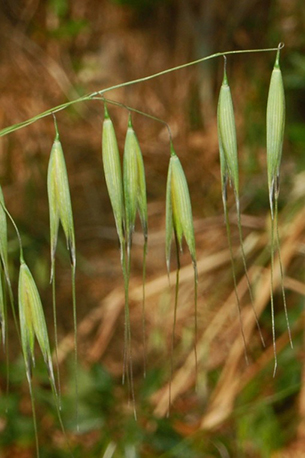
Triticale (×Triticosecale Wittmack)
Triticale is a hybrid of wheat and rye, developed in Scotland and Germany in the late 19th century. It can be used for feed grain or forage production, including green chop and silage.
It is usually planted as a winter or spring crop in Maine, being sown 45 days before the first frost or as the first crop of the year, approximately at the end of April or the beginning of May. Stem elongation will not occur without vernalization (cold temperatures), so sowing it in early fall is not recommended. It is adapted to a wide range of soils and requires only moderate fertility and moisture. It does not tolerate flooding and is only slightly drought-resistant. Triticale has better winter hardiness than oats but less than winter rye.
Triticale can be used for silage if harvested on the boot stage, but dry matter yields are higher at later maturity stages than other small grains. Its growth habit is similar to wheat and rye.
Triticale seeding rate is 40–60 pounds per acre as a cover crop or 80–100 pounds per acre for early spring or early-middle fall forage. Sow seeds 1–1.5 inches deep using a seeding drill or apply at broadcasting by adding at least 30 percent more seed.
Triticale fertilization should be done considering the results of soil analysis. Nutrient requirements are similar to wheat and rye. Triticale requires approximately 40–60 pounds of nitrogen per acre for optimal growth, with 20 pounds of phosphate (P2O5) and 90 pounds of potash (K2O) as forage. A productivity of 3–4 tons per acre can be expected.
Some varieties available in Maine are Hyoctane (good winter hardiness), Nitrous (late maturity with high leaf-stem ratio), Surge (medium maturity, suitable for haylage), or Gainer (early maturity).
Wheat (Triticum aestivum L.)
Wheat can be classified as soft white wheat, used in pastries, crackers, cookies, or breakfast cereals, and soft red wheat, which is more resistant to pre-harvest sprouting. Wheats are preferably used as winter crops, sowing in mid-September or October. Select areas with moderate to good drainage and fertility, as wheat does not tolerate very wet or hardy soils.
The recommended seeding rate is 90–120 pounds per acre, expecting at least 40 heads per linear foot of row when planted in 7-inch rows. This ensures a desired population of 1.3–1.5 million plants per acre. Use a higher seeding rate to reduce the incidence of weeds, burying the seeds 1–1.5 inches deep.
Determine lime and fertilizer needs by soil test and maintain pH between 6 and 7. If no soil test is available, apply 60 pounds of nitrogen per acre, limiting 20 pounds of nitrogen one week after planting and the remainder by topdressing at least three weeks later.
The University of Maine Cooperative Extension conducted a wheat variety trial in 2012-2013, testing the performance and nutritive value of Arapahoe, Maxine, AC Morley, Redeemer, and Harvard varieties in central Maine. The best performance was observed by AC Morley and Harvard, with a yield of 2–3 tons per acre as green forage. The sowing was done in mid-September, and 75, 130, and 245 pounds per acre of nitrogen, P2O5, and K2O were applied respectively, according to the recommended soil test. The research concluded that increasing the seeding rate reduced 21 percent of weed biomass for all varieties, without effect on grain yield or protein content.
Yields and grain weights are often lower for spring wheat than winter wheat. Spring wheat is usually a hard red type that is not easily marketable in the conventional soft red winter wheat markets. It could be used to make high-protein bread flour if a potential market exists. The Glen variety is one of the earlier and better-yielding spring wheat varieties in the New England region.
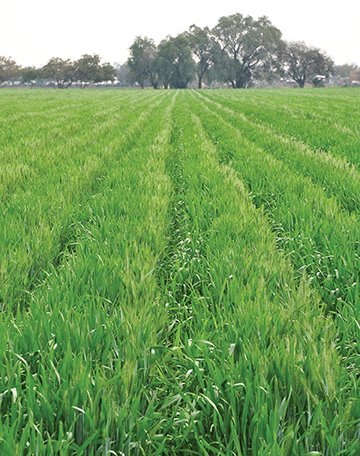

Rye (Secale cereale L.)
Rye comes from Europe and is the most winter-hardy of all the small grains crops in Maine. It is often grown as a winter cover crop and can be used for grain, forage, or straw in the late stages of maturation. It is adapted to a wide range of soils but requires moderate fertility and moisture. It tolerates drought, low pH, and low fertility, but performs best in well-drained soils with a pH between 6 and 6.5.
Due to its winter hardiness, winter rye is usually used to extend the grazing season, offering green biomass until November, when snowing starts. Additionally, it can provide one more cut in early spring, promoting early weed control. Rye can germinate and grow up to 33 °F, although performance is not good at those low temperatures.
Rye may release root exudates that inhibit the germination and growth of weed seeds. These allelopathic effects and cereal rye’s ability to smother other plants with cool weather growth make it an ideal choice for weed control.
However, allelopathic compounds may also suppress the germination of small-seeded vegetable crops if planted shortly after incorporating cereal rye residue. Large-seeded crops and transplants rarely are affected. Evidence shows that the amount of allelopathic compounds in tillering plants is lower than in seedlings.
Rye’s typical seeding rate is 80–100 pounds per acre, increasing to 140 pounds in late seeding or for broadcasting. Reduce the rate to 50–60 pounds per acre when mixed with legumes or as a cover crop. Fertilizer requirements are similar to wheat, applying 50–90 pounds per acre of nitrogen depending on yield potential. Be careful of applying too much nitrogen, as excessive biomass growth may result in lodging if harvested for grain. Hybrid rye usually requires less fertilization.
Compared to other cereal grains, rye grows faster in the fall and produces more dry matter the following spring, up to 10,000 pounds per acre, although 2 tons per acre is more typical in the Northeast.
As forage, the best time for grazing is at the booting stage, when seedheads begin to form. In pastures, the right time is when 30 percent of the rye has flowered.
Horse owners find rye straw desirable, particularly when it has been cut early (before grain formation), bleached white by the sun, and baled without rain damage.
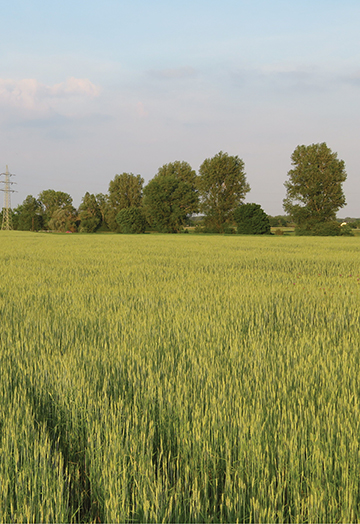
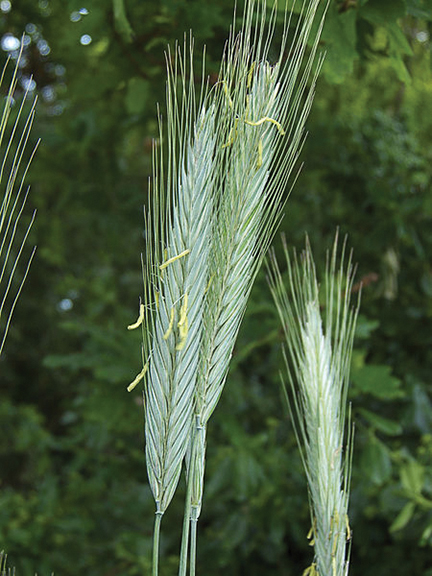
Buckwheat (Fagopyrum esculentum Moench)
Buckwheat is a broadleaf, annual crop that reaches 2–5 feet tall. It has a single, succulent stem with several branches. The flowers vary from white or light green to pink or red. It forms a dense, fibrous root system with a deep taproot. Most of its roots are concentrated in the top 10 inches of the soil.
Buckwheat is a fast-growing cover crop and is most useful for reduced-chemical or nonchemical weed suppression. Buckwheat will shade and smother weeds or outcompete them for soil moisture and nutrients. Both living buckwheat plants and buckwheat residues have an allelopathic effect on weed germination. The best way to take advantage of allelopathy is to cut or mow buckwheat at flowering, managing it as a mulch instead of incorporating it into the soil. Research shows that the allelopathic effects of buckwheat can last about 30–60 days. To suppress weeds, buckwheat should be planted 30-50 days before planting the cash crop. Two consecutive plantings will have a greater effect on weeds than one planting.
Buckwheat can also be used for grain and green mulch production, producing 1,000–1,500 pounds per acre of green biomass per harvest.
Buckwheat is well adapted to poor soils and will lodge on highly fertile soils. It performs better at 6 and 6.5 pH but can tolerate more acidic soils and may produce reasonable yields above 5.5 soil pH. Typical nutrient requirements are minimal for buckwheat, with no fertilizers needed on high-testing soils. On the contrary, apply 25–30 pounds per acre of nitrogen, 20–30 pounds per acre of P2O5, and 0–20 pounds per acre of K2O.
Optimum sowing dates for buckwheat are commonly 12 weeks before the first frost, approximately in late June or early July in Maine. Buckwheat will bloom in cool temperatures, from mid-August to early September. Early planting risks flowering during the warm season. Buckwheat usually takes 12 weeks to mature, ripening in early October.
The best seeding rate for buckwheat is 40–55 pounds per acre. The seed can be broadcast or drilled. Drilling requires less seed and produces a more uniform stand. The higher seeding rates should be used when the seed is broadcast. For best results, seed into a weed-free, well-prepared field. After seeding, irrigate as necessary to establish the crop. Seedlings emerge 3–5 days after sowing.
Drill seeds ½–1 inch deep. Shallower depths are preferred if the soil is moist and loose. Seeds may also be drilled into existing residue or killed sod, but good contact of the seed with the soil is important.
Buckwheat must be harvested when ¾ of the seeds are ripe (brown and hard) but before significant shattering occurs. Windrowing for 7–10 days before harvest can decrease shattering losses and increase yields.
Current buckwheat varieties in Maine are common buckwheat, Lifago (later bloom), and VNS (fast-growing).

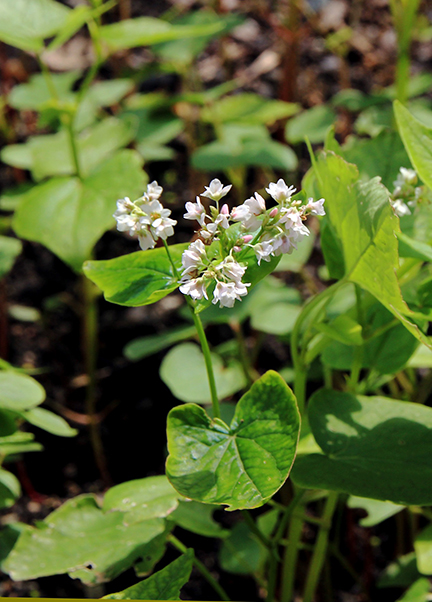
References
Carrijo DR & Roth GW. (2021). Part I, Section 7, Small Grains. In the 2023–2024 Agronomy Guide. Pennsylvania State University. University Park (PA), United States. pp 95-100.
Cover Crop Resources. (2023). Triticale. University of Wisconsin-Madison. Madison (WI), United States.
Grubinger V. (2021). Winter rye: A reliable cover crop. University of Vermont Extension. Burlington (VT), United States.
Kersbergen R, Mallory E & Molloy T. (2010). Growing Organic Cereal Grains in New England, (Bulletin 2207). University of Maine Cooperative Extension.
King’s Agriseeds Inc. Seed catalog.
Mallory E & Molloy T. (2019). Oat Variety Trial. University of Maine Cooperative Extension. Orono (ME), United States.
Mallory E & Molloy T. (2013). Winter Wheat Planting Date Trial. University of Maine Cooperative Extension. Orono (ME), United States.
Seedway-Growmark Inc. Seed catalog.
Thomas-Murphy J, Amsili J, Bergstrom G, Cherney J, Hansen J, Helms M, Hunter M, Kettering Q, Lawrence J, van Es H, Smith E, Smith M, Stanyard M & Workman K. (2023). Cornell Guide for Integrated Field Crop Management. University of Cornell Cooperative Extension. Ithaca (NY), United States. pp 125-134.
University of Wyoming Extension. (2023). Forage identification: Rye. University of Wyoming. Laramie (WY), United States.
Valenzuela H & Smith J. (2002). Buckwheat. Cooperative Extension Service, University of Hawaii at Manoa. Honolulu (HI), United States.
Information in this publication is provided purely for educational purposes. No responsibility is assumed for any problems associated with the use of products or services mentioned. No endorsement of products or companies is intended, nor is criticism of unnamed products or companies implied.
© 2024
Call 800.287.0274 (in Maine), or 207.581.3188, for information on publications and program offerings from University of Maine Cooperative Extension, or visit extension.umaine.edu.
In complying with the letter and spirit of applicable laws and pursuing its own goals of diversity, the University of Maine System does not discriminate on the grounds of race, color, religion, sex, sexual orientation, transgender status, gender, gender identity or expression, ethnicity, national origin, citizenship status, familial status, ancestry, age, disability physical or mental, genetic information, or veterans or military status in employment, education, and all other programs and activities. The University provides reasonable accommodations to qualified individuals with disabilities upon request. The following person has been designated to handle inquiries regarding non-discrimination policies: Director of Equal Opportunity, 5713 Chadbourne Hall, Room 412, University of Maine, Orono, ME 04469-5713, 207.581.1226, TTY 711 (Maine Relay System).


